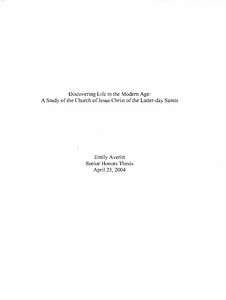Discovering Life in the Modern Age: A Study of the Church of Jesus Christ of the Latter-day Saints
Author
Averitt, Emily Elaine
Subject
Washington and Lee University -- Honors in Religion
Church of Jesus Christ of Latter-day Saints
Christian sects
Religions
Metadata
Show full item recordDescription
Debate over prayer in schools, priests convicted of child molestation, the potential of yet another denominational split, and low attendance on Sunday mornings have invaded news cameras across America. At first thought, it appears as if these issues are pointing to the collapse of religion in our society or at least the collapse of traditional religious authority and trust. Amongst this religious wreckage, however, religion is thriving in new forms. W estem religion, as our society traditionally accepts it, is on the rise: Roger Finke and Rodney Stark claim that 62% of America was "churched" in 1980 compared to 17% in 1776, and they attribute such success to the revitalization of old traditions and the creation of new ones like the Mormon Church. Also, secular cults, such as the cult of Science, Michael Jackson, Dr. Phil, are emerging as a new religious form. Modernity and secularization are often the two movements attributed for the collapse of religion, and thus, they should be the center of any study looking at religious growth and failure today. However, instead of looking directly to modernity to understand religion's fate, it is most helpful to look to the religions themselves. In
understanding successful religions today, we can better understand the modem person, which brings a greater understanding of modernity. Which religions have proven successful and what do they tell us about the person modernity produces? [From Introduction]
